|
 





Mohawk Midgetape
44
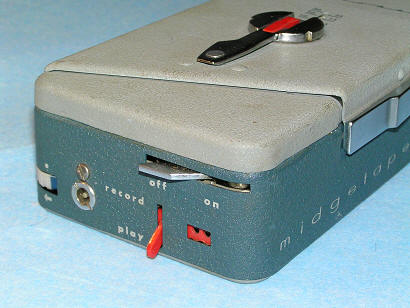
Used Google
translator
Mohawk Midgetape 44 (BR-1).
The very first of a
series of recorders Mohawk Midgetape company "Mohawk
business machines corp. Brooklyn 33. N.Y. ", USA.
It produced
since 1955,
and was worth
$
249.50.
In 1954,
it was
announced, and promised
to sell at $
197.50, but
in 1955 it
had
advertised with a price of
$ 249.50.
In the photo
from left to
announce in the
magasine
"Tape Recording" №8
of 1954,
further
advertising in the same
journal in
1955. However,
in the August
issue of "High Fidelity
Magazine" for
1955 it
had
advertised with a price of
$ 229.50
- pictured
right.
Perhaps the
price of
different
complete sets.
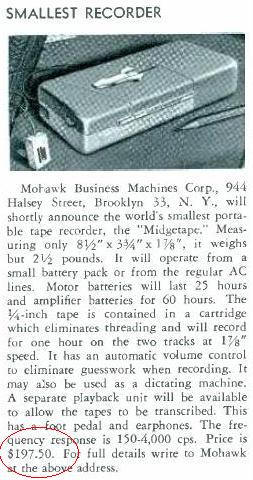
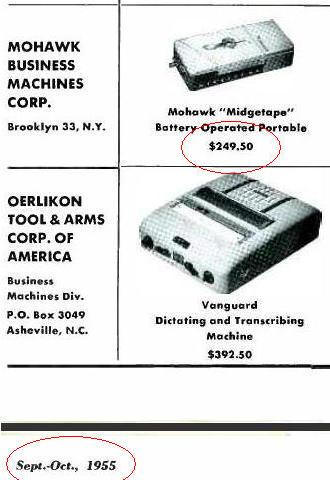
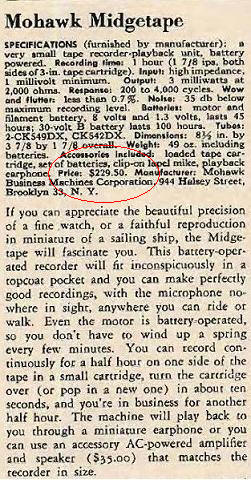
Later models
were made
Midgetape 300,
Midgetape 400
and 500 Midgetape "Professional". Model Midgetape 44
originally sold under the name Midgetape BR-1, and on my
copies made in 1956, there are both markings and
Midgetape 44 and BR-1. Structure and kinematics of all
models are nearly identical. Read more about this in the
description
Mohawk_Midgetape_300.
The main feature of Midgetape
44 is that its wiring diagram is made on radio tubes. In
this amplifier uses three subminiature radio tubes XFY54 (1
pc.), And XFW40 (2 pcs.). They are inserted into the
five-contact socket, mounted on a ceramic
(steatite) plate
measuring 25 x 24 x 1 mm, which is in turn soldered to
the window textolite board amplifier. On the ceramic
plate are also planar capacitors and resistors amplifier
circuit. In fact, the whole amplifier is built
on this ceramic plate, and textolite board placed only a
few minor details. For 1956
all performed very technologically.
All ceramic capacitors amplifier, and the circuit
no electrolytic capacitor. Since the recorder tube, it
requires three voltages, 9 v - for motor, 1,5 v - for a
filament of radio tubes, and 30 v - anode voltage. In
fact, these radio tubes designed for the anode voltage
15 - 22 v, and to have enough battery 24 v. Homemade
battery, which I have made instead of the original is
made of two batteries of 12 v, type MN.
Also in the recorders
could be used in radio tubes - type counterparts CK542DX
and CK549DX,
or CK525AX
and CK512AX..
Kinematics of the recorder is very simple, but provides
a stable speed of the tape. Fast forward is absent, and
rewind by using flip handles, located on the upper lid.
Versatile and erase heads are united in molded monoblock.
To connect a microphone uses a round connector and
headphone jack and output cable - simple two-contact
connector without a key. Built-in speaker in the
recorder there. As an accessory to the
recorder sold to the external amplifier - the speakers.
Сервис онлайн-записи на собственном Telegram-боте
Попробуйте сервис онлайн-записи VisitTime на основе вашего собственного Telegram-бота:
— Разгрузит мастера, специалиста или компанию;
— Позволит гибко управлять расписанием и загрузкой;
— Разошлет оповещения о новых услугах или акциях;
— Позволит принять оплату на карту/кошелек/счет;
— Позволит записываться на групповые и персональные посещения;
— Поможет получить от клиента отзывы о визите к вам;
— Включает в себя сервис чаевых.
Для новых пользователей первый месяц бесплатно.
Зарегистрироваться в сервисе
Mohawk Midgetape 44 (BR-1)
with an external amplifier - speaker (photo from
Internet)
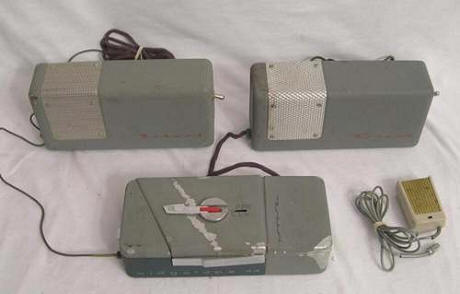
The device was
bought in a faulty state. The sound was, but
very weak, and amid loud crackling. Repair was quite
difficult, but I managed to find the faulty capacitor on
a ceramic board amplifier. In the process of repair, I
checked the radio tubes, and tried to pick up their
analogues. It turned out that the scheme works fine with
the Russian radio tubes 06P2B (analogue
XFW40)
and 1P3B
(analogue XFY54). In this case the frequency
characteristics of the amplifier to improve. Kinematics
was almost a working, required only lubrication of
bearings, and replace the rubber belt unit rolling. The main belt,
made of coiled steel spring, I do not have to. Currently,
the recorder works perfectly, as new. Externally, the apparatus is preserved
very well, and mechanics was also a little worn.
Apparently they are not used for a long time, most
likely he quickly broke down, and forgot about it.
The
recorder came with the original batteries. One of them -
b-battery 30 v, such as Eveready № 506, the other - the
battery of the engine and glow of tubes, such as 2X62X
Burgess. This battery has three contacts, one medium -
common (-), and two side with voltages + 9 v, and + 1,5
v. New same battery, I gathered from six batteries AAA,
and one AA.
Also included with the recorder I got the original
cassette (cartridge), the original crystal microphone,
unfortunately failed, and the connecting cable to
connect to an external amplifier. The tape has an
unusual design with the coils located one above the
other.
Her body and all the
details in full metal. Tape, 1 / 4 inches short
of 1 hour of recording (2 x 30 min.). At
a speed of 1, 7/8 inches per second.
Dimensions recorder 220 x 100 x 55 mm. Weight complete
with batteries and tape - 1,3 kg. Net weight 0,9 kg.
Photos can be enlarged
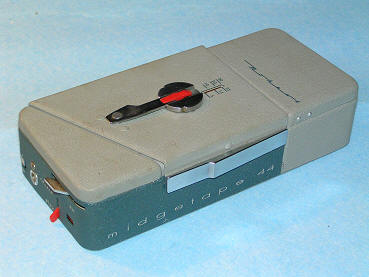
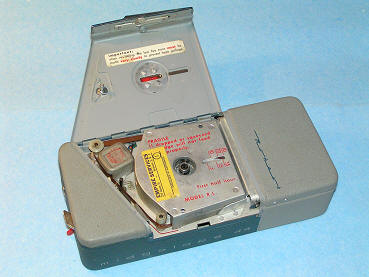 
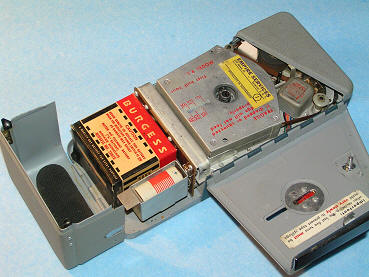 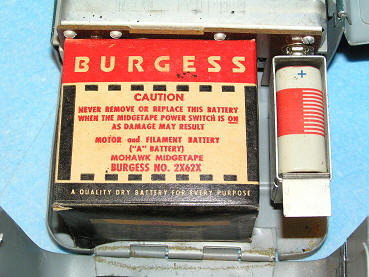
 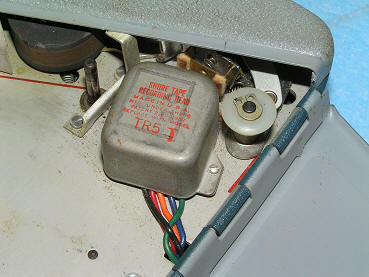
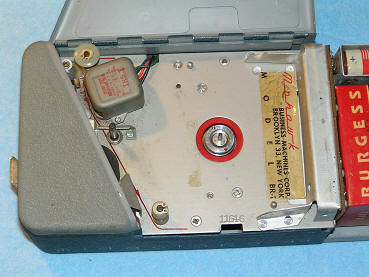 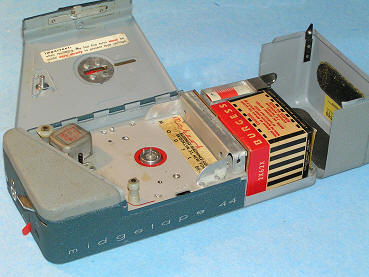
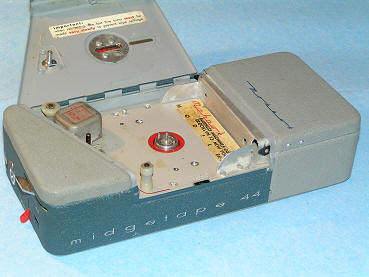
The photo on the left of
the apparatus with the original batteries. In the photo
on the right improvised.
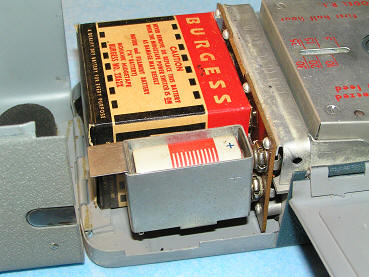 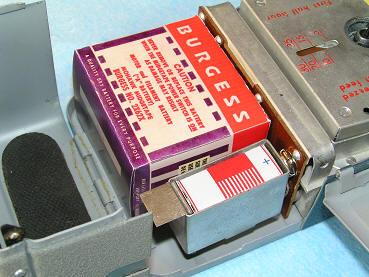
On the left picture view of the apparatus
below. One can see the two screws fixing the kinematics
to the shell. In the larger picture right is marking the
date of manufacture - NOV 23 1956 OK
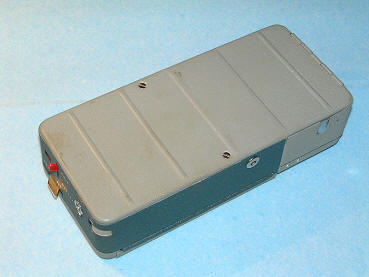
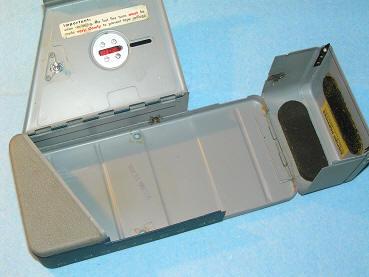 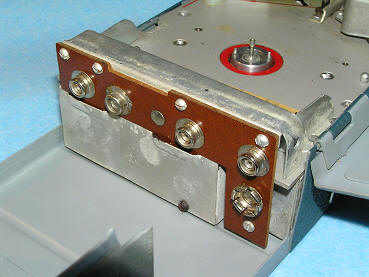
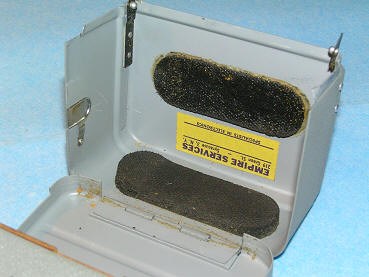 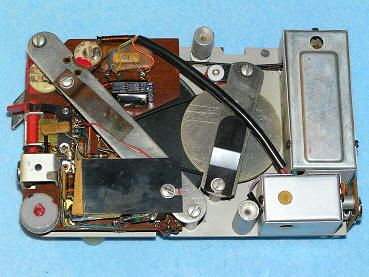
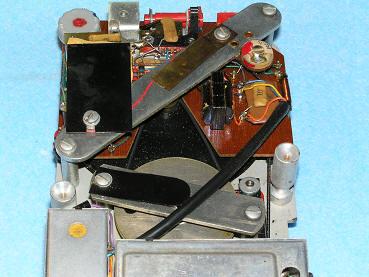 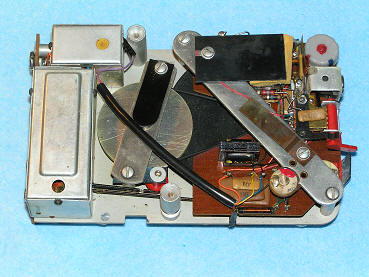
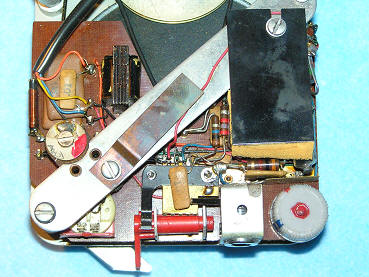 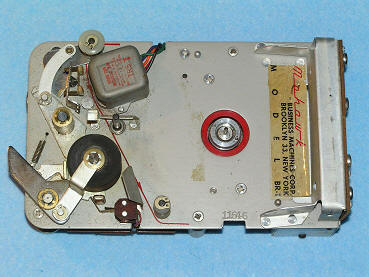
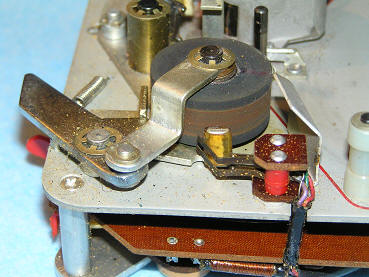 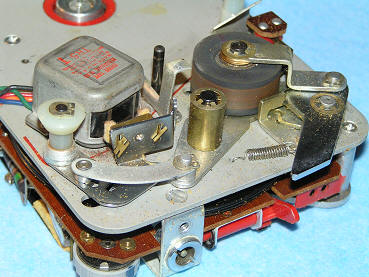
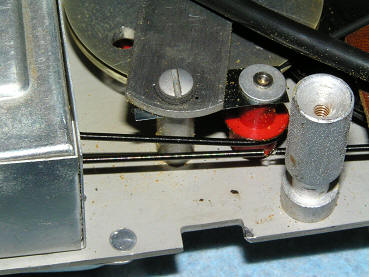 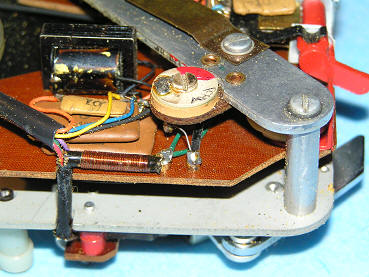
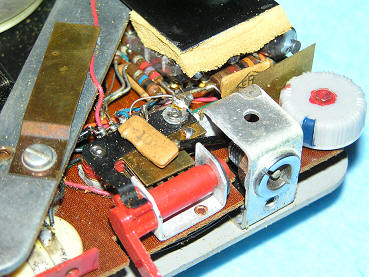 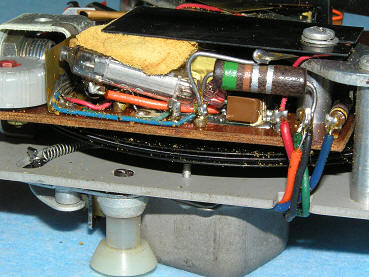
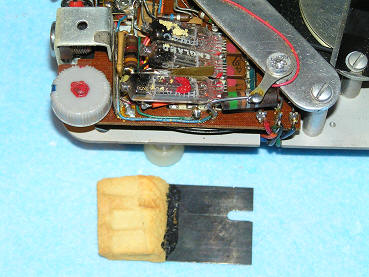 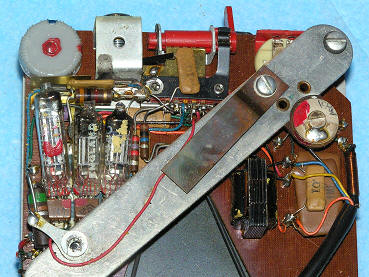
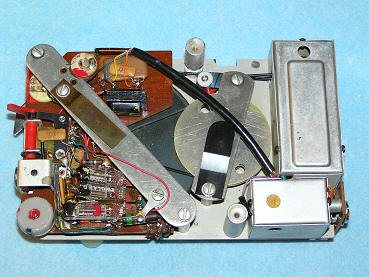 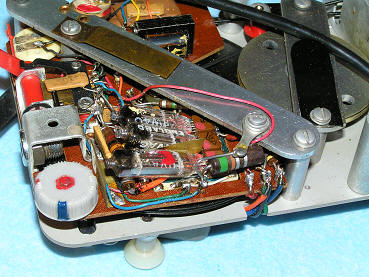
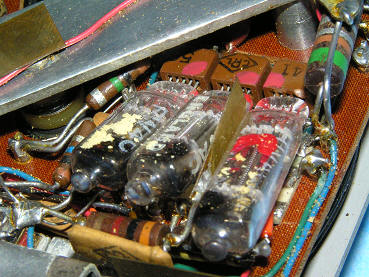
Dimensions without motor centrifugal
regulator - 49 x 28
mm
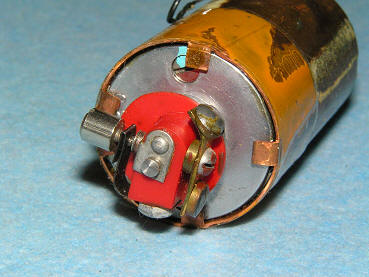
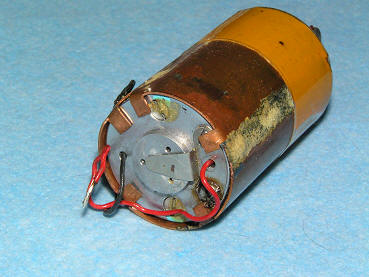
Electric motor speed regulator on the
lamp with filter.
It is located in a metal box near the
electric motor
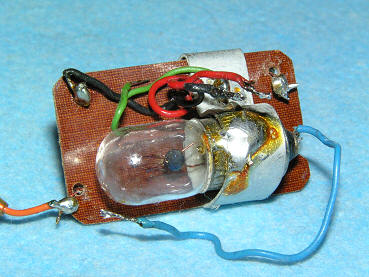
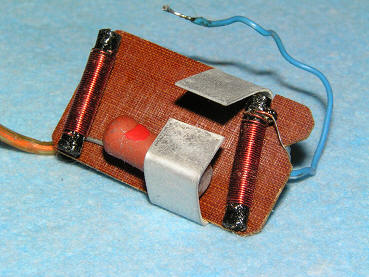
The original
radio tubes.
Longer -
XFY 54 (32
x 6
x 8 mm.).
Two short
- XFW40 (27 x 8.5 x
6 mm.)
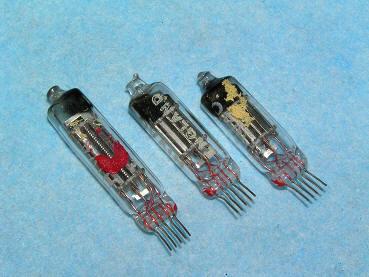
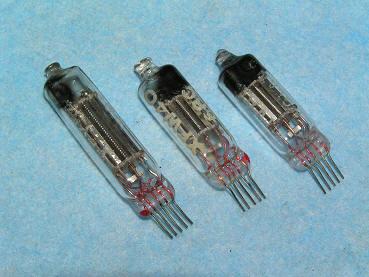
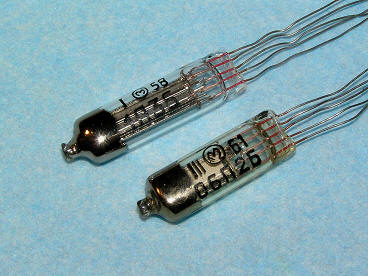 |
|
Tubes
1P3B and 06P2B
-
Soviet counterparts
XFY54
and XFW40.
Passport
size
38 x 10.2
x 7.2
mm and 32
x 10.2
x 7.2
mm. The actual
dimensions of
37 x
10 x 6.7
mm and 30
x 10 x
6.7
mm. |
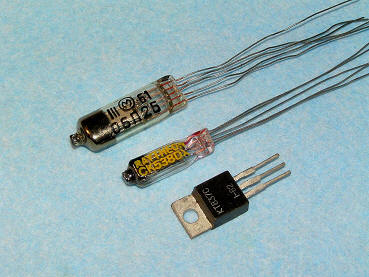 |
|
Similar
Subminiature
radio tubes
from different manufacturers
vary in size.
Some of the
small
radio tubes
manufactured by
"Raytheon".
For example, the lamp
CK538DX (analogue
and
XFW40 06P2B)
has dimensions of
just
25.4 x
7.2 x
5.6 mm and
it is
commensurate with the
size of
transistors. |
.
When repairing
the amplifier
had to unplug the
lamp module.
On the left he is
in his place,
he pictured right
unsoldered,
and you can see
an empty window
in
the amplifier board
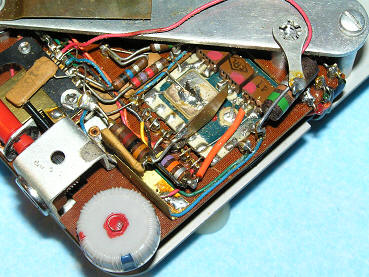
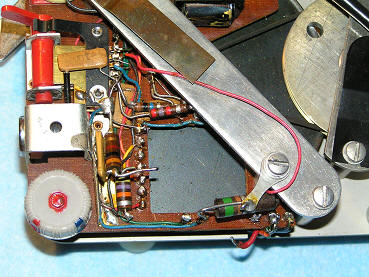
On the ceramic plate
located lamp socket, planar capacitors and resistors
amplifier circuit.
Such modules for hearing aids began to be produced in
1945, (the
same in PDF) and during the war, this technology
produced modules for military use.
Look at the report on the symposium on printed circuits,
which was held in 1947 in the United States.
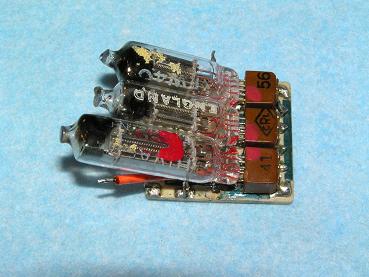
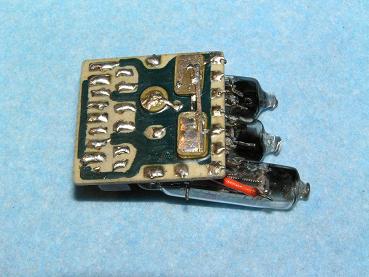 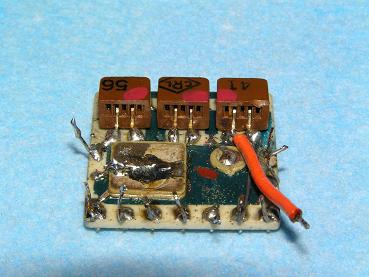 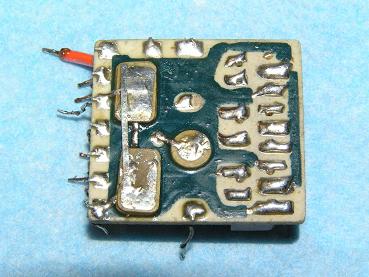
|
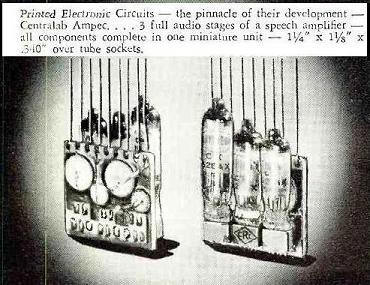 |
|
Mohawk
Midgetape started
producing in 1955,
such
as subminiature
modules
audio amplifier
company
"Centralab"
started producing commercially in
1945.
These photos
I found
in a magazine
"Radio & Television News"
of
August 1950. In
addition to these
modules, they are
ready
to assemble the radio
components,
capacitors, resistors
on a ceramic substrate
in a miniature
version, such as
such
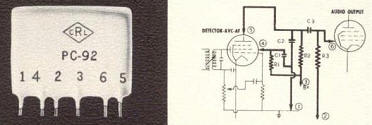 |
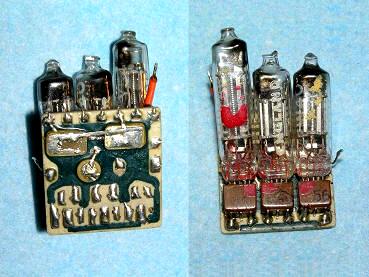 |
|
Manufacturing technology is described in the
magazine "Radio & Television News" №12 for 1949. Conductive tracks on the ceramic substrate made
by photo printing emulsion with silver powder
and fusing in a furnace. The resistors were
formed by applying to a substrate through a
stencil graphite resistive paint, followed by
firing in a furnace.
As can be seen,
the recorder
module
is very similar to
that described
in the
magazine
"Radio & Television News"
of
August 1950, but
there are some differences.
In fact
there were several
modifications
in the
illustrated
magazine
module
"PC-201
Model 2" and
in my
recorder module is used
"PC-203
Model
3" or
"PC-205
Model
3",
which
have the same
circuit. |
|
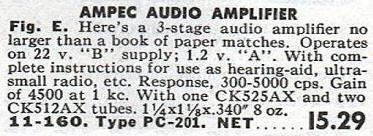 |
|
Description
of the amplifier
module
"Ampec" from the catalog
"Allied Radio"
for
1952. There is also a
description and
other modules
manufactured
by this technology. |
|
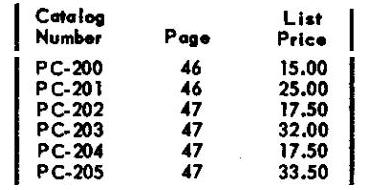 |
|
In
"Centralab Catalog №
29"
shows the prices for
all models of these
amplifiers.
Modules
PC-200,
PC-202 and PC-204,
sold
without the vacuum
tubes and the
model
PC-201,
PC-203 and PC-205
supplied
with
radio tubes,
respectively, and
they cost
differently.
I must say that
such prices
at that time
were
not small.
For comparison, for
example a stationary
reel tape
cost about
$ 100. |
|
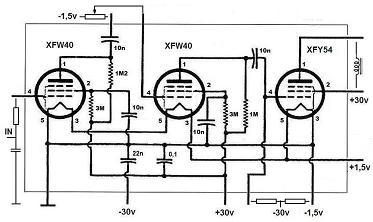 |
|
The original
scheme
of the recorder
at the time
I did not have, but
it completely
and I
did not need, since
he
was only a faulty
lamp module.
During the
repair
I made
sketches
of his
scheme, and
now brought them to
order and
make a normal
picture.
Accurate
resistor values.
The values of
the capacitors
are approximate, but
it is not critical,
since such schemes
normally work
with a large
spread
of denominations
and resistors
and capacitors.
On the
enlarged
picture
everything
in sight.
|
|
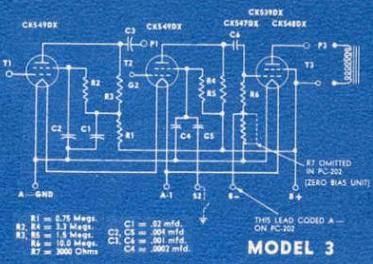 |
|
The circuit
modules
"PC-203
Model 3"
and
"PC-205
Model 3",
presented in the
"Centralab Catalog №
29"
is slightly different
from the one I
drew.
Also in the catalog
indicates the use of
the lamp module
CK512AX, CK547AX, CK548AX,
CK549AX, DX, but
are not mentioned
CK525AX, CK542AX, DX, XFY54
and
XFW40, which are also
used
in them. This could
mean that in addition
to basic
and other
modifications
were
not listed
in the directory. |
Schematic diagram
Mohawk Midgetape
44 (BR-1)
of the
service manual, which I
recently managed to acquire.
I scanned
it, and
placed at the bottom of
the page
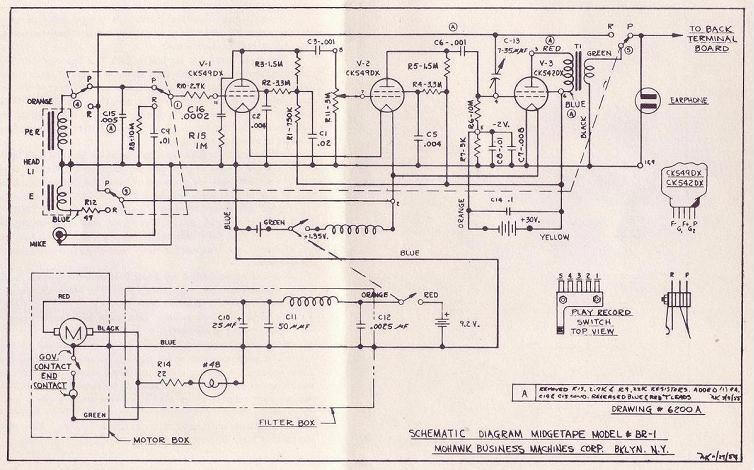
Another version of
the three
radio tube
amplifier module
"Centralab",
but with the volume control and
output transformer.
Photos from
the magazine "Radio &
Television News" №12 for 1949.
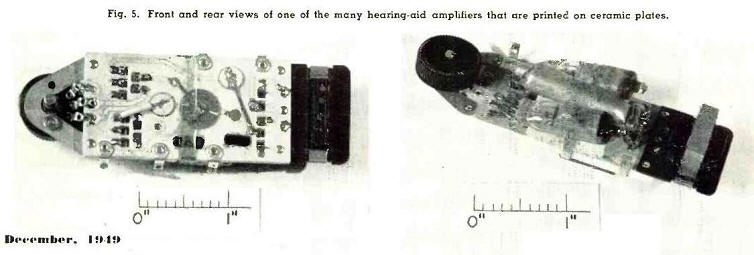
Actually, it turns out
that such a portable tape recorders could appear much
earlier, back in the 40s. Technology tape recording time
has already been, and everything else, mechanical parts,
engine and compact batteries is not a problem in the
manufacture and sub-miniature radio tubes began
producing commercially in 1940. This example CK501X,
CK502X, CK503X, CK504X production of Raytheon. The truth
is the first such lamps were somewhat larger than it is
now - 39.7 x 14 mm and in the version with base, they
became even greater. The marking lamp base absent index
X, - CK501 ... CK504.
The first mention of
these lamps I
have found in the catalog
"Allied Radio"
in 1940

 |
|
|
|
The
last
advertisements
of the
lamp
in a
version
I found in the
"Radio Chack Catalog"
for
1945.
Please note
that for five
years
the price
has not changed
However,
at the same
time it is made
smaller radio tubes index
AX |
|
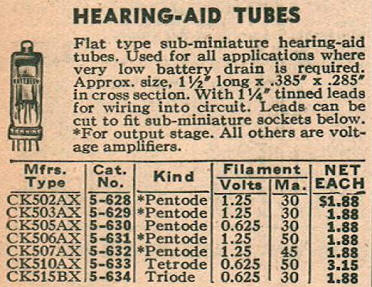 |
|
Familiar sizes today have lamps "Raytheon" with
the AX index, which began to be produced during
the war.
It is in this version like radio tubes have
become very popular and widely used in the
future of diverse radio equipment, even in
aviation and space.
Subsequently, similar lamps made even smaller
sizes, such as radio tubes
DF64, DF651,
CK538DX is measured only
25.4 x 7.2 x 5.6 mm.
I
should add that the use of such lamps in the
portable equipment first mastered in Germany.
In 1951 we began to produce the
first "pocket" wire recorder
"Minifon Mi51",
assembled in three subminiature lamps type DF67
and DL67. |
Original battery type
2X62X. Dimensions 60 x 55 43 mm. Weight 210 g.
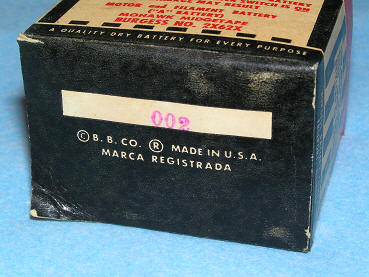
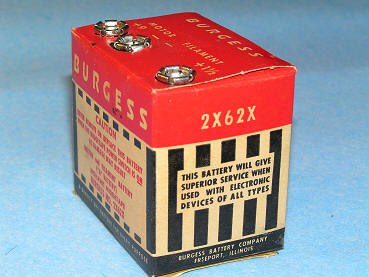 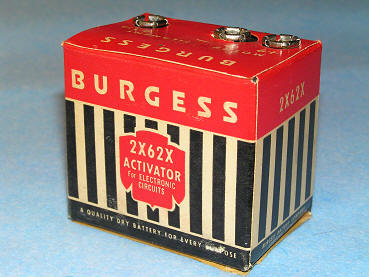
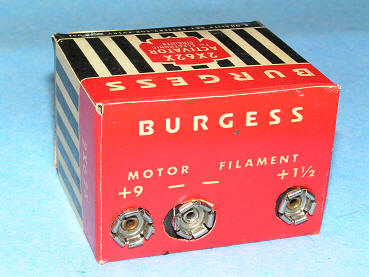
The battery is assembled with 14
elements, covered with resin.
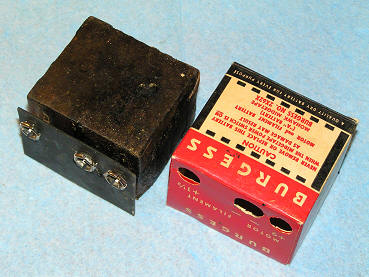
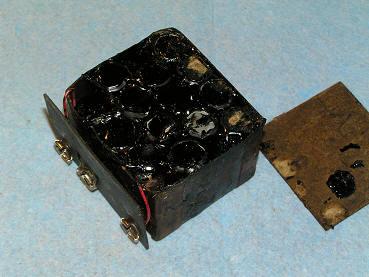
Homemade battery made of six AAA
batteries, and one AA batteries. For the manufacture of
cardboard boxes used a scanned image of the original.
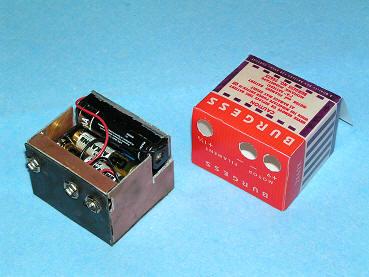
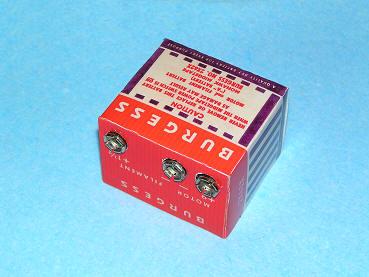
The original battery 30 v such as
Eveready ¹ 506. The sizes 35 х 29 х 15 mm. Weight of 25
g. The battery is inserted into the steel container, and
squeezed it flat shaped spring.
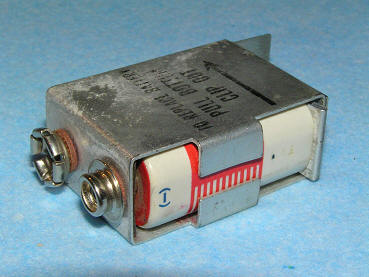
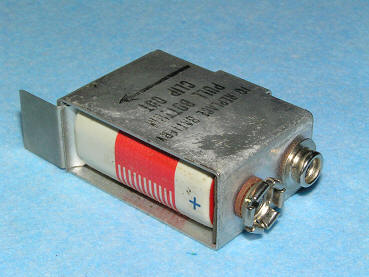 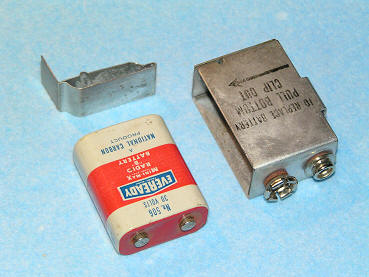
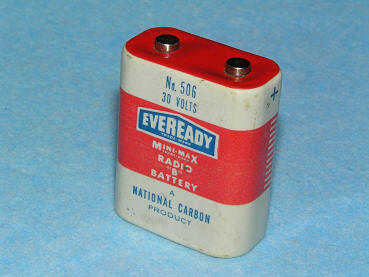 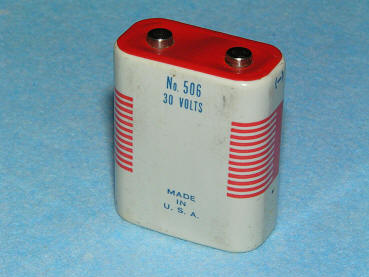
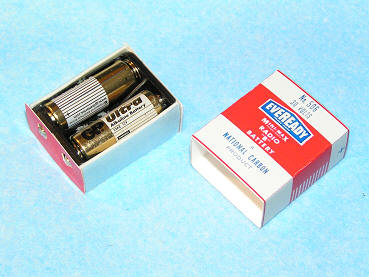
Homemade battery 24 v is made of two
batteries of 12 v type MN. To supply anodes 24 v enough,
since they are calculated on the anode voltage 15 - 22
v.
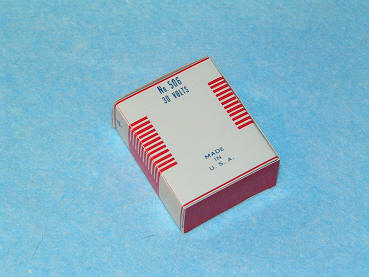
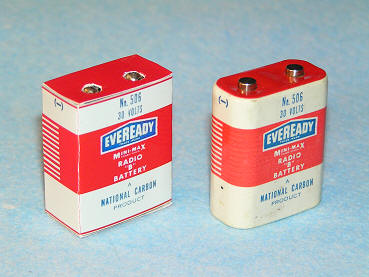
The original tape unassembled. The body
and all parts of iron, and coils located one above the
other. The width of the film 1 / 4 inches. Hours 1 hour
(2 x 30 min).
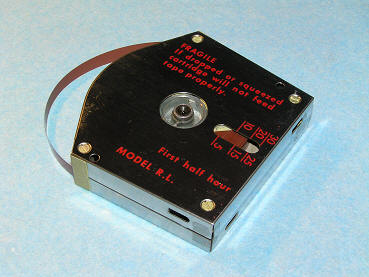
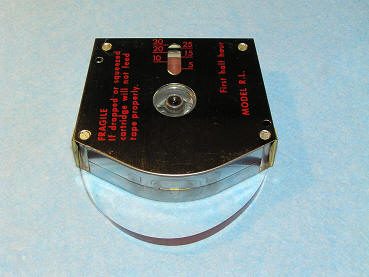 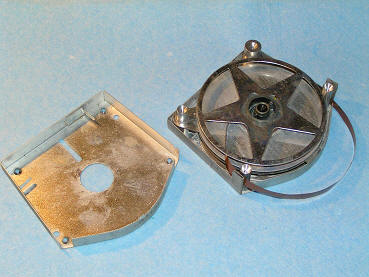
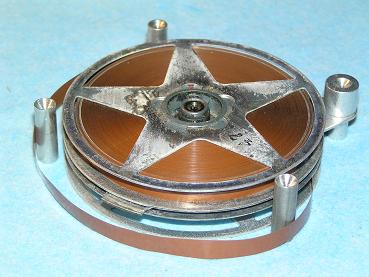
Connection cable for
connection to an external amplifier. Has a shunt
resistance of 2.2 kom.
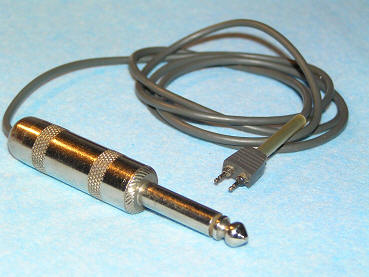
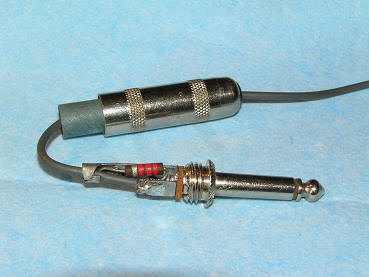
Crystal microphone and the original packaging.
Unfortunately, it turned out to be defective. Capsule
microphone consists of an iron shell with aluminum
membrane, under which the crystal. After opening of the
membrane revealed that the crystal was destroyed.
Crystal Repair I used from another microphone. Now the
microphone is in working condition.
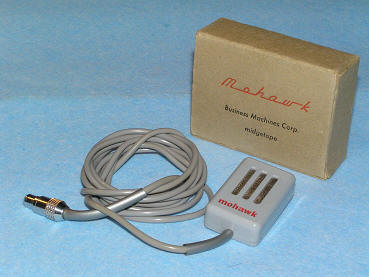
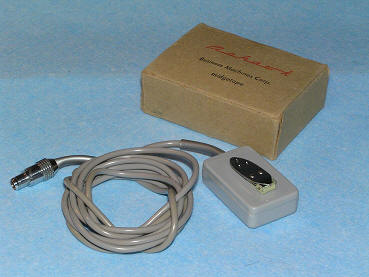 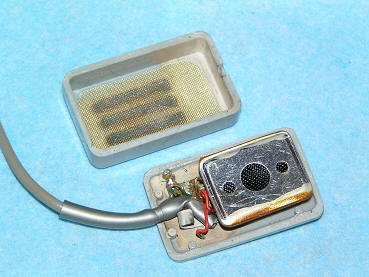
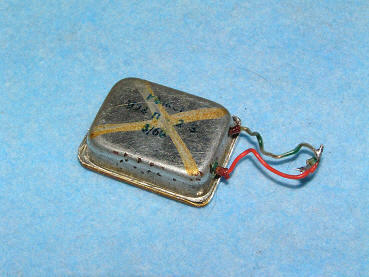 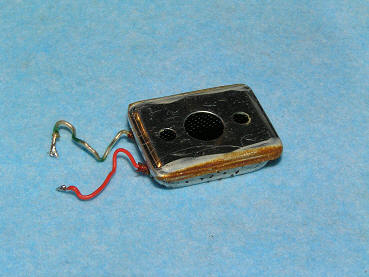
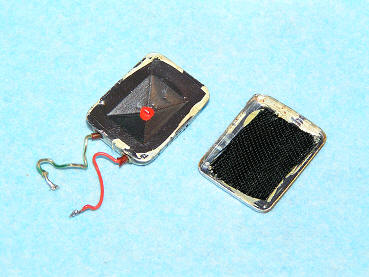
Service Manual
recorder
Mohawk Midgetape BR-1
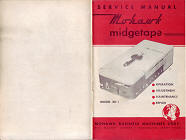
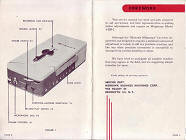
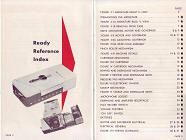
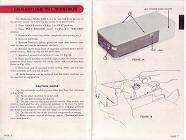 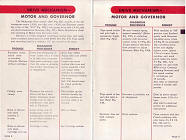
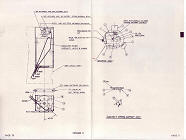
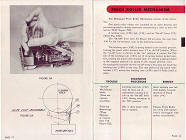
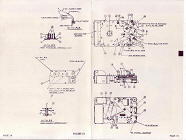 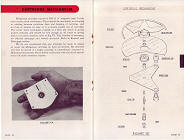
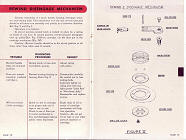
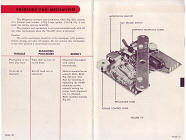
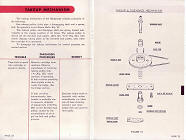 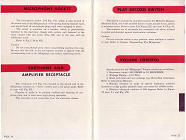
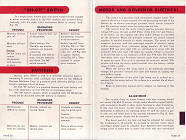
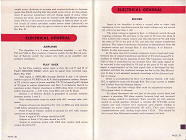
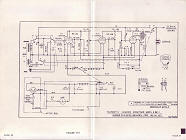
The construction of all
types of recorders Mohawk Midgetape same.
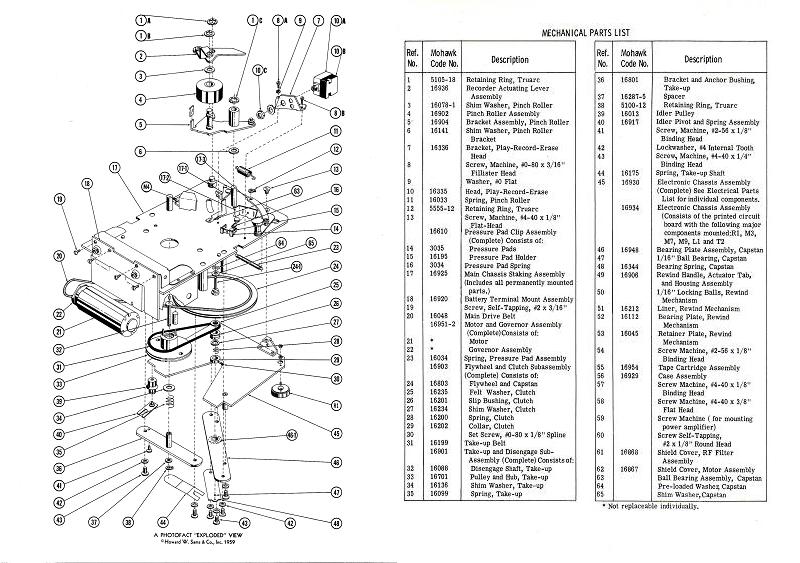


|

![]()
![]()
![]()
![]()
![]()
![]()
![]()












































































































